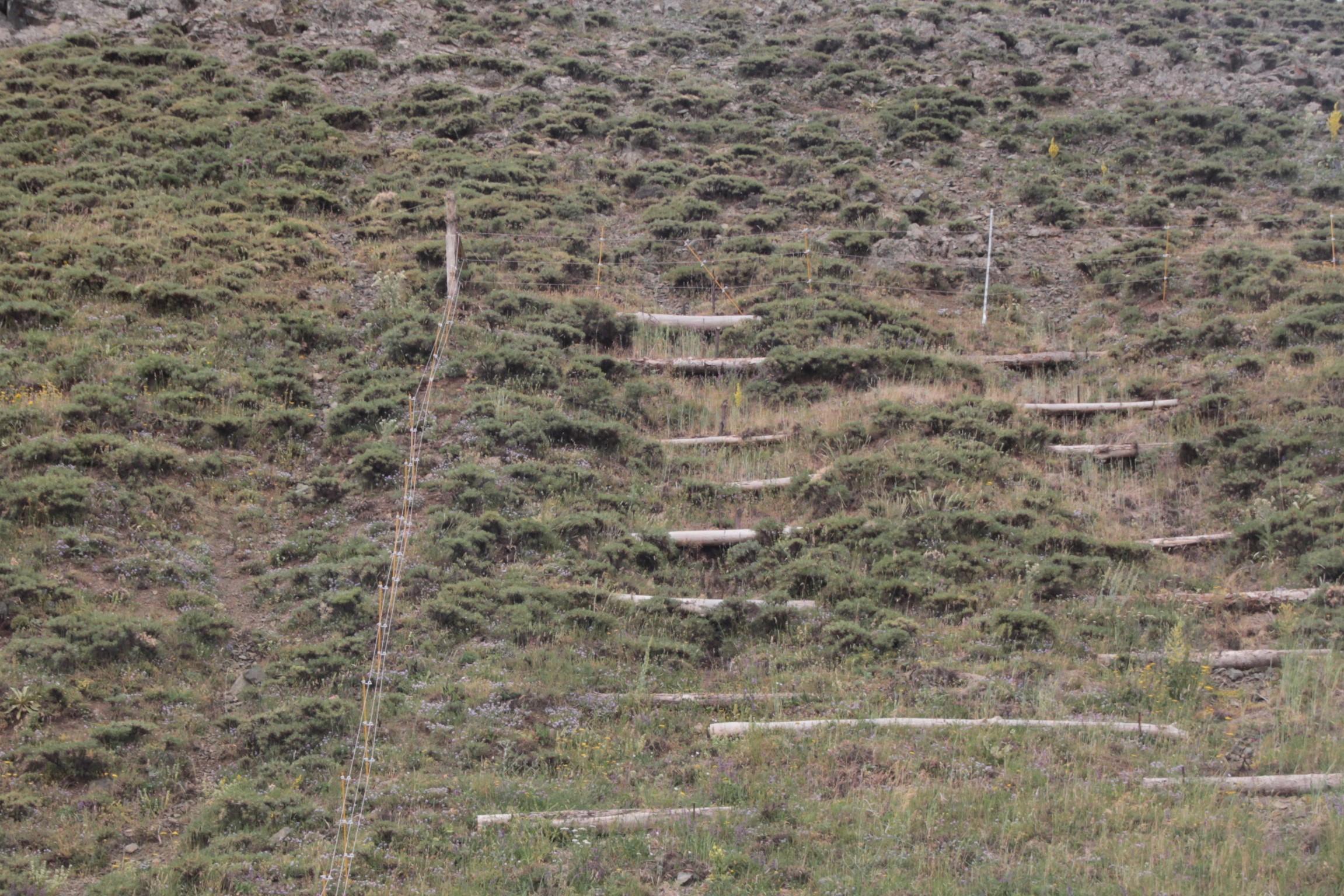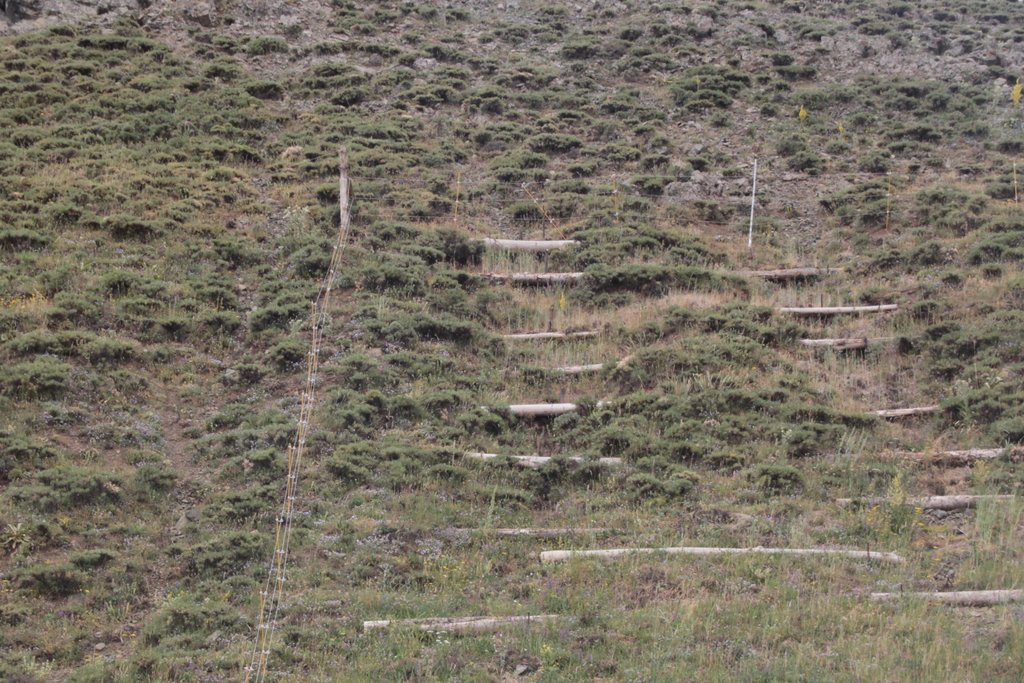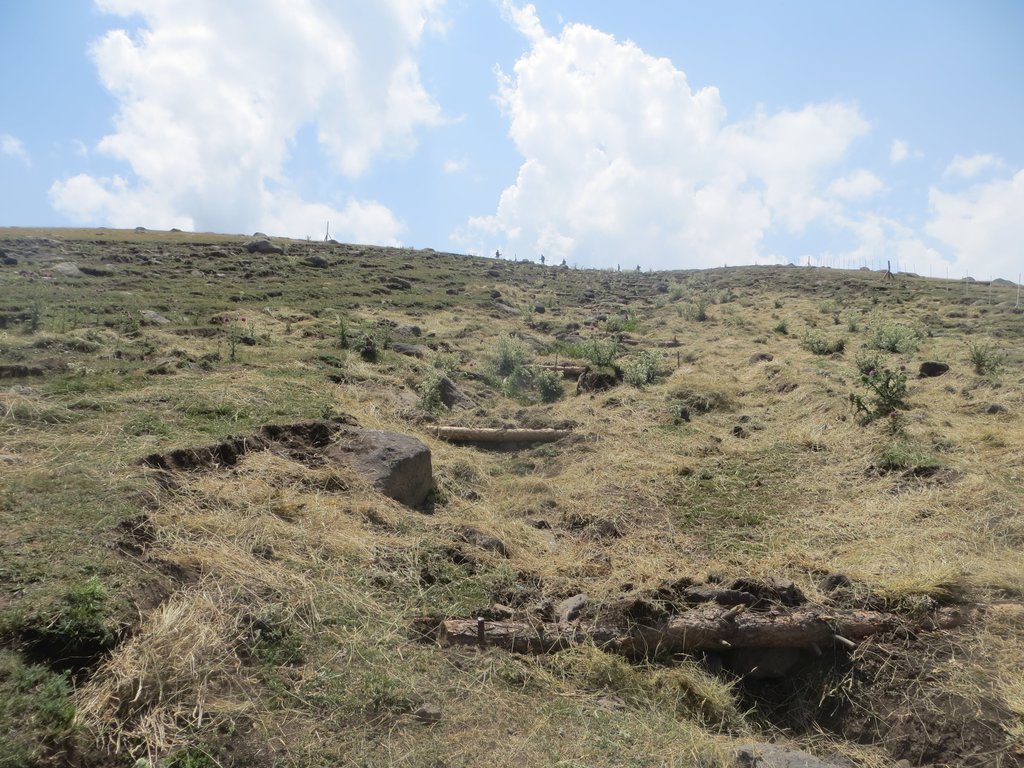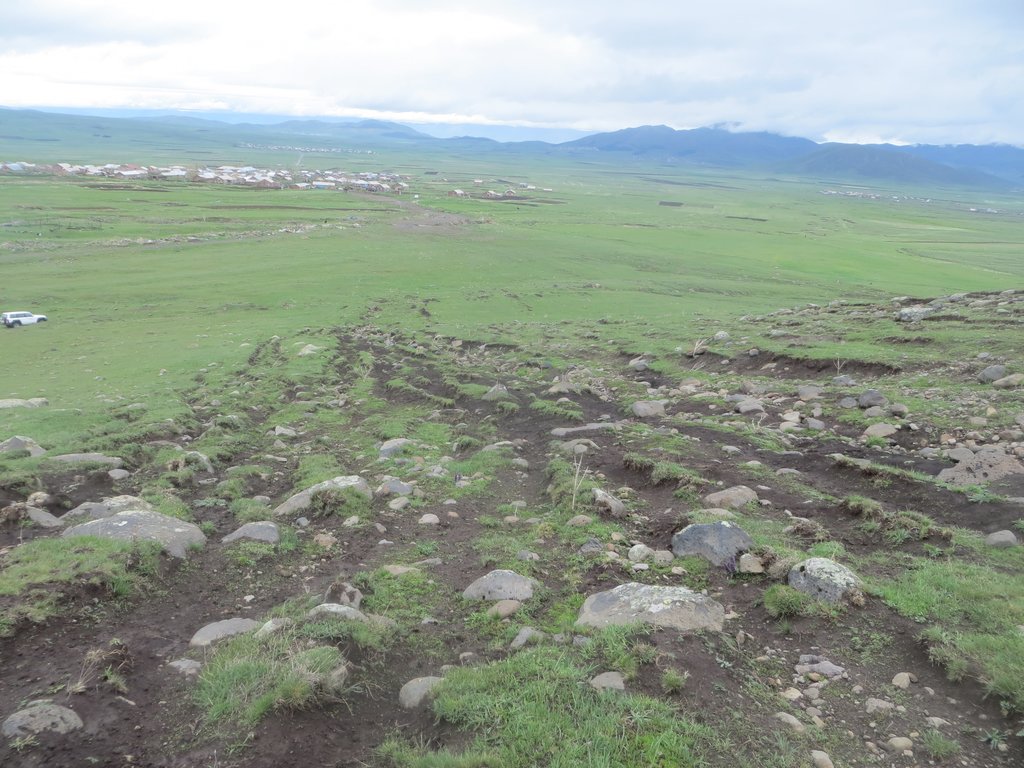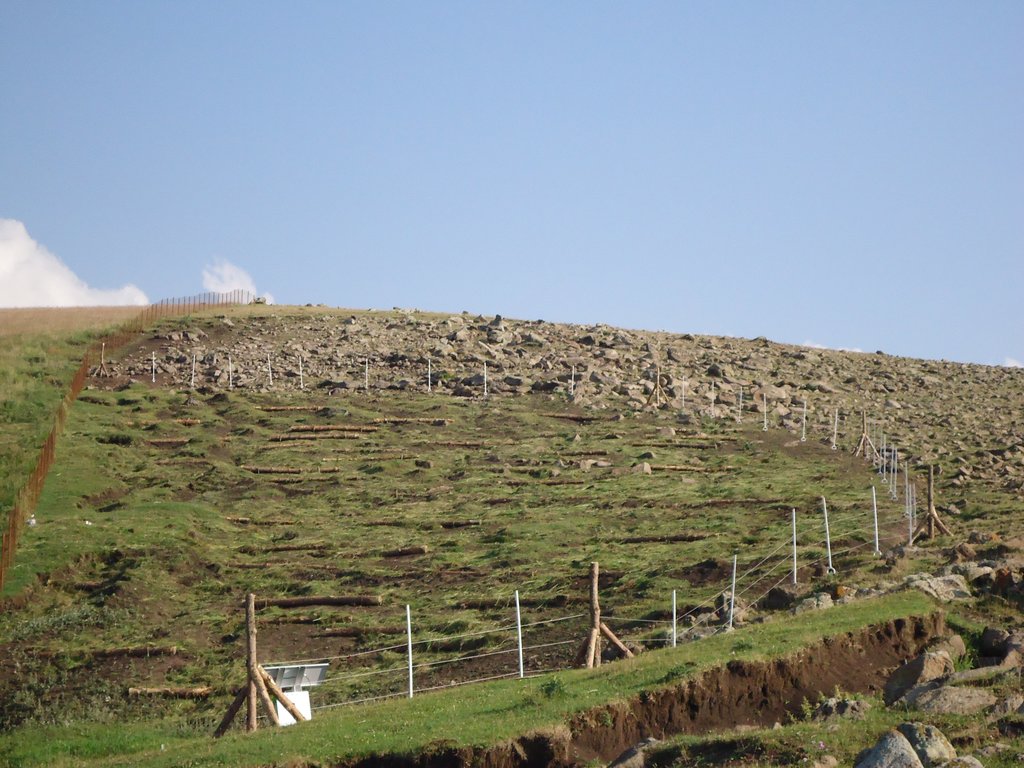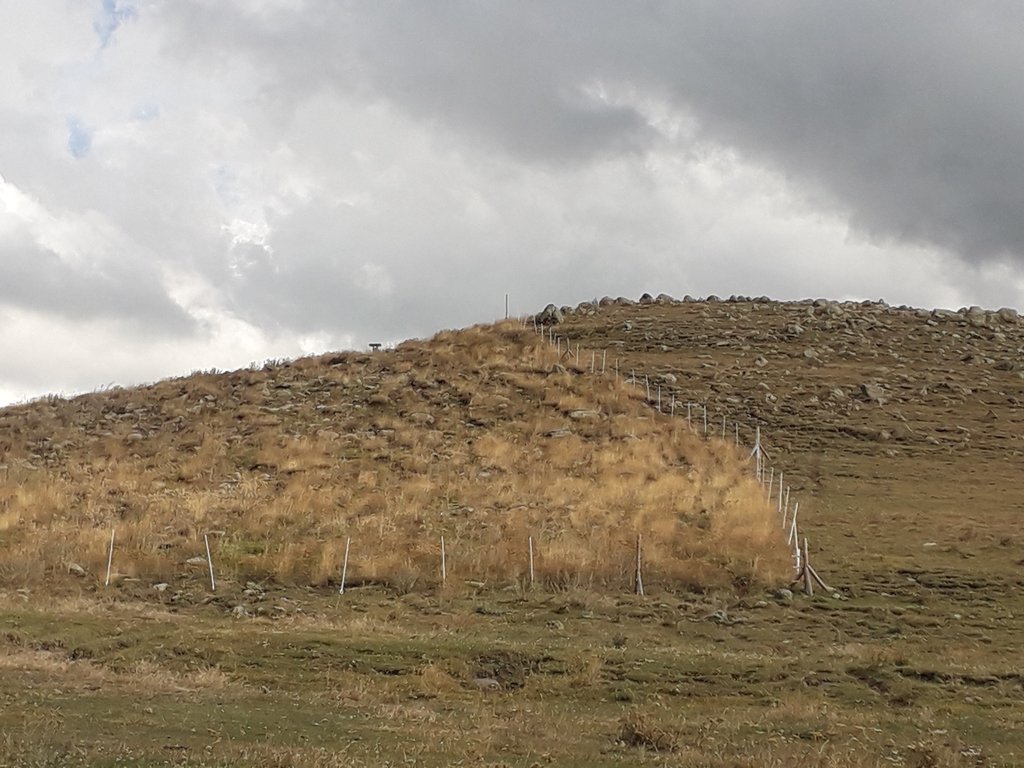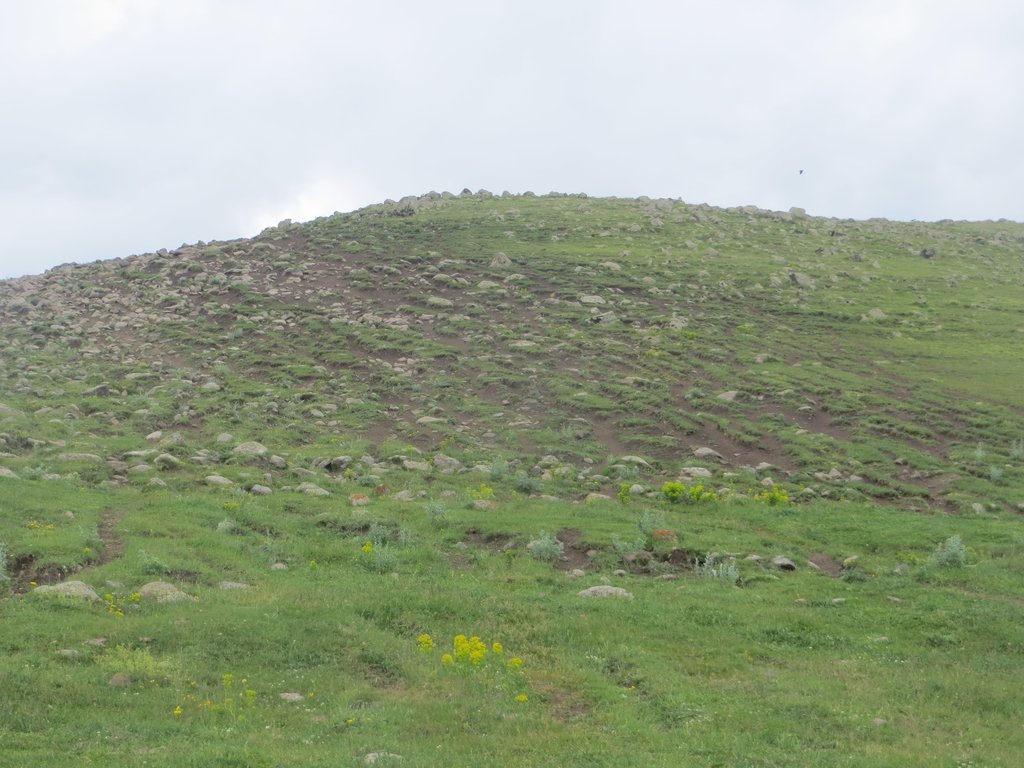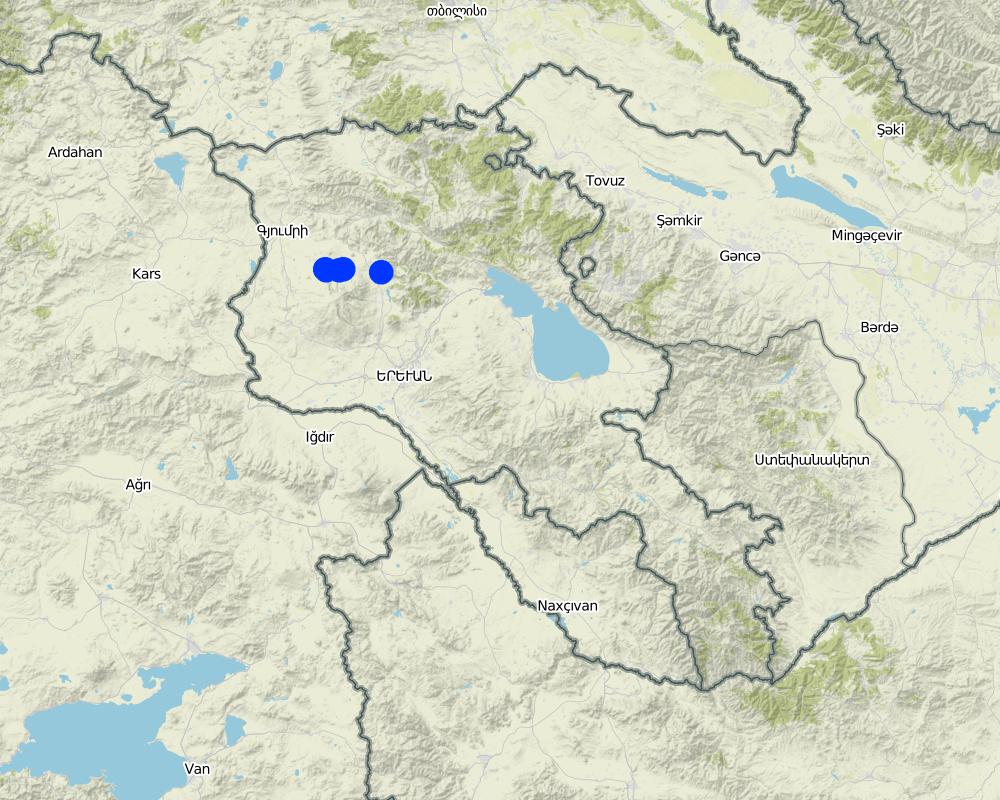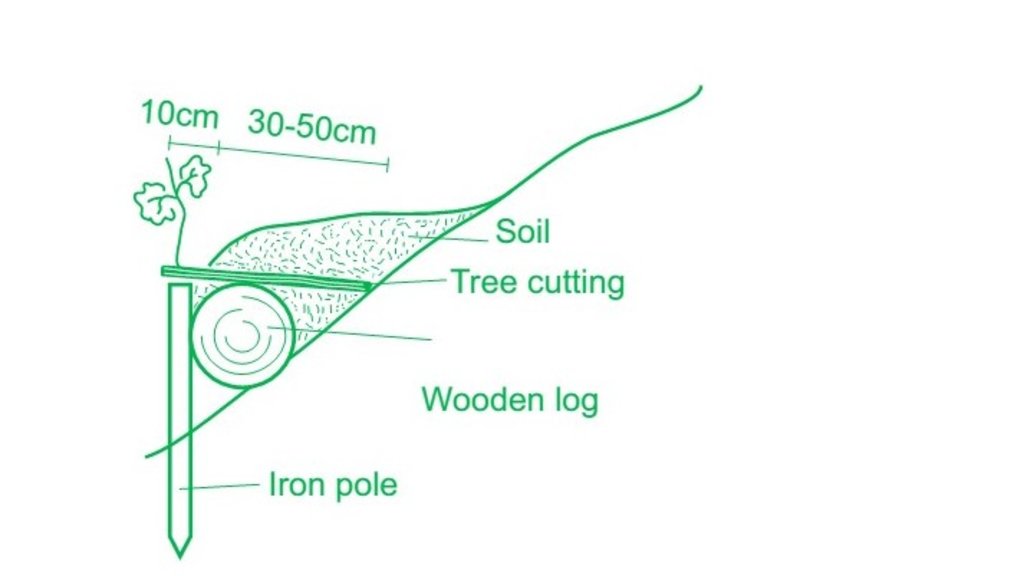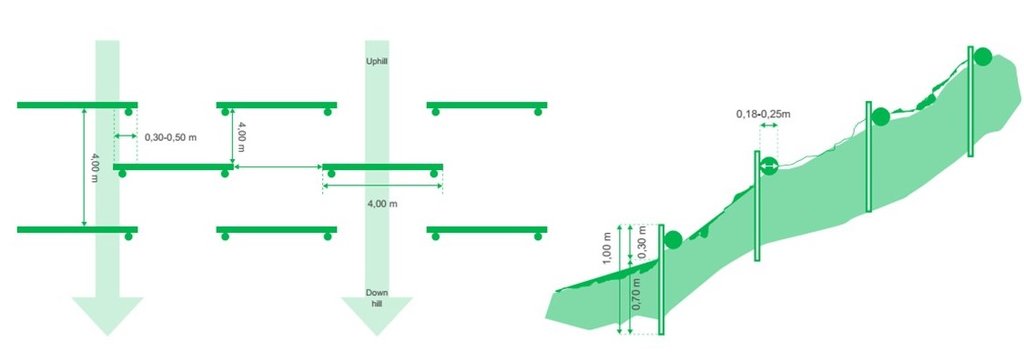Slope erosion control using wooden pile walls [亚美尼亚]
- 创建:
- 更新:
- 编制者: Hanns Kirchmeir
- 编辑者: Artur Hayrapetyan
- 审查者: Ursula Gaemperli
technologies_4092 - 亚美尼亚
查看章节
全部展开 全部收起1. 一般信息
1.2 参与该技术评估和文件编制的资源人员和机构的联系方式
关键资源人
SLM专业人员:
Mnatsyan Aghasi
+374 (0)96001193
aghasi.mnatsyan@giz.de
GIZ
4/1 Baghramyan Street, 0019 Yerevan, Armenia
亚美尼亚
SLM专业人员:
Khachatryan Hrant
+374 94 839083 / +374 91 926092
hkhachatryan84@gmail.com
ESAC NGO, Armenian National Agrarian Univercity
Yerevan, Davit Anhaght 23
亚美尼亚
SLM专业人员:
Huber Michael
0043463504144-24
huber@e-c-o.at
E.C.O. Institute of Ecology
Lakeside B07b 9020 Klagenfurt
奥地利
有助于对技术进行记录/评估的项目名称(如相关)
Integrated Biodiversity Management, South Caucasus (IBiS)有助于对技术进行记录/评估的机构名称(如相关)
Deutsche Gesellschaft für Internationale Zusammenarbeit (GIZ)1.3 关于使用通过WOCAT记录的数据的条件
(现场)数据是什么时候汇编的?:
03/10/2018
编制者和关键资源人员接受有关使用通过WOCAT记录数据的条件。:
是
1.4 所述技术的可持续性声明
这里所描述的技术在土地退化方面是否存在问题,导致无法被认为是一种可持续的土地管理技术?:
否
1.5 请参阅有关SLM方法的问卷
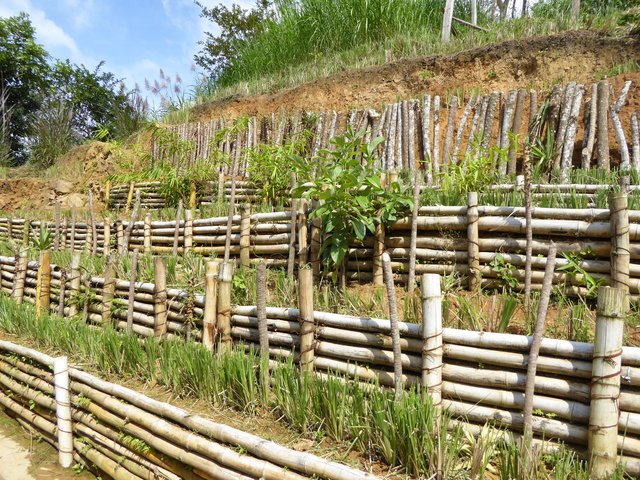
Estabilización de laderas de manera participativa [洪都拉斯]
La bioingeniería comprende una serie de técnicas que utilizan materiales vegetativos vivos para prevenir la erosión y el deslizamiento de laderas y taludes. Las obras de bioingeniería se aplican a base de un análisis integrado de riesgo, son de multi-uso en su conjunto, tienen un bajo costo de construcción y …
- 编制者: Helen Gambon
2. SLM技术的说明
2.1 技术简介
技术定义:
Small horizontal wooden structures and terraces on eroded slopes built to mitigate sheet or rill erosion and slow down water run-off. The technology is easy to apply and efficient to mitigate erosion processes of the upper soil layer and to stop small rock falls.
2.2 技术的详细说明
说明:
In the provinces of Aragatsotn and Shirak in Armenia, the weather is cold and temperate with dry summer. Steep slopes, pastures and some autochthonous oak forests make up the area. Farmers make most of their income with grazing by manual labour. The carrying capacity of pastures in the vicinity is regularly exceeded, and they degrade more and more. In order to stabilize the steep eroded slopes, pile walls were established. Pile walls are horizontal constructions along a slope, functioning as erosion control measures by slowing down the superficial water runoff, retaining materials and supporting the rehabilitation of vegetation.
The major advantages are: It is not expensive since mostly locally available materials can be used, and a positive effect can already be observed within a year. Also, the pile walls can be established relatively easy without any need of heavy machinery or specific knowledge and, therefore, allow the involvement of the local population.
In the case of the implementation in Armenia, the exact location for the pilot measures was selected in such a way that grazing activities were almost not impaired. For temporary exclusion of livestock, electric fencing was used. Within the fenced area, pile walls were established in the washed-out rills along the slope to address the water erosion phenomena.
The technical requirements and workload for the construction of a pile wall are relatively low. The needed resources require iron piles, a hammer, wooden logs (or a bundle of branches) and tree cuttings. First, the wooden logs were cut in 1-2 m length to fit into the irregular rills of the slope. After identifying the locations of individual pile walls, the team fixed the logs with iron poles of about 70-100cm length. The distance between the pile walls varies between 1-3m, depending on the topography: the steeper the slope, the closer the distance. The space behind the logs was filled with soil, plant material and rocks to stabilize the construction and to reduce the risk of water washing out the soil and passing below the logs. As a last step, the terraces were covered with hay to provide protection against precipitation and to accelerate re-growth of grass through the seeds contained in the hay residuals.
Community members were surprised how easy and quick the pile walls could be established. A team of two workers established a pile wall within 30 min. Since these areas are usually intensively used and thus are of high importance for the community, even a temporary exclusion from use must be thoroughly discussed and agreed upon.
The measure slows down vertical water-run off and provides steps for cattle. Due to temporary fencing and the application of hay mulch vegetation is recovering on these parts.
2.3 技术照片
2.4 技术视频
注释、简短说明:
https://www.youtube.com/watch?v=Apt2D9i18a0
ESAC Project Video
日期:
27/03/2018
位置:
Argatsotn/Shirak Marz
摄影师的名字:
ESAC
2.5 已应用该技术的、本评估所涵盖的国家/地区/地点
国家:
亚美尼亚
区域/州/省:
Aragatsotn and Shirak Marzes (Provinces)
有关地点的进一步说明:
Lusagyugyh, Hnaberd, Ghegadhzor, Saralandj, Mets Mantash
Map
×2.6 实施日期
如果不知道确切的年份,请说明大概的日期:
- 不到10年前(最近)
2.7 技术介绍
详细说明该技术是如何引入的:
- 通过项目/外部干预
3. SLM技术的分类
3.1 该技术的主要目的
- 改良生产
- 减少、预防、恢复土地退化
- 保持/提高生物多样性
- 降低灾害风险
3.2 应用该技术的当前土地利用类型

牧场
粗放式放牧场:
- 半游牧/游牧
主要动物种类及产品:
cattle (and sheep)
3.3 有关土地利用的更多信息
该技术所应用土地的供水:
- 混合雨水灌溉
每年的生长季节数:
- 1
牲畜密度(如相关):
0.89-1.30 pasture load/ha
3.4 该技术所属的SLM组
- 畜牧业和牧场管理
- 改良的地面/植被覆盖
- 最小的土壤扰动
3.5 技术传播
具体说明该技术的分布:
- 均匀地分布在一个区域
如果该技术均匀地分布在一个区域上,请注明覆盖的大致区域。:
- < 0.1 平方千米(10 公顷)
3.6 包含该技术的可持续土地管理措施

植物措施
- V1:乔木和灌木覆盖层
- V2:草和多年生草本植物

结构措施
- S1:阶地
3.7 该技术强调的主要土地退化类型

土壤水蚀
- Wt:表土流失/地表侵蚀
- Wg:冲沟侵蚀/沟蚀
- Wm:块体运动/滑坡

土壤风蚀
- Et:表土流失

物理性土壤退化
- Pc:压实

生物性退化
- Bc:植被覆盖的减少
3.8 防止、减少或恢复土地退化
具体数量名该技术与土地退化有关的目标:
- 减少土地退化
- 修复/恢复严重退化的土地
4. 技术规范、实施活动、投入和成本
4.1 该技术的技术图纸
4.2 技术规范/技术图纸说明
Required materials for 1 pile wall:
- 2 iron poles (0.7-1m) and a hammer
- 1 wooden log (ca. 4 m, 20-25cm diameter)
- 10-20 shrub cuttings (e.g. Salix species)
Selection of appropriate sites for pile walls (where and how to put them):
The logs are being spread on the slope as indictated in the scheme of the figure. The steeper the slope the narrower the vertical spacing in between (max. 4m, min. 1-2 m). On uneven slopes, place the along the depressions as these are the areas where water-run off is strongest. Parts which show no erosion signs can be left out to not destroy existing vegetation cover. The location of the pile walls is determined by the slope and serves to stabilize the slope at superficial level (10-30 cm). It landslides occur that involve deeper soil layers, this technology is not efficient.
Building process:
After placing the logs, those are fixed with two irons at the end (alternatively wooden posts can be used as well). After fixing the logs, the space behind needs to be filled (slight terracing of the slope). Additionally, either shrub seedlings or living cuttings from species such as willows (ca. 50cm long, 2-5cm diameter) should be integrated. Finally, the open soil should be covered by a layer of 2-5 cm of hay/grass containing seeds and eventually additional seeds (from local species) to promote the re-establishment of vegetation. This has also the benefit that this cover keep humidity in the soil, which is particularly important in (semi-)arid areas.
Species used/density:
At least 20 cuttings per pile wall should be planted. Depending on the survival rates, it can be also more. Shrubs additionally stabilize the slope and are to some extent protected by the pile wall.
4.3 有关投入和成本计算的一般信息
具体说明成本和投入是如何计算的:
- 每个技术区域
注明尺寸和面积单位:
0.15 ha
具体说明成本计算所用货币:
- 美元
注明雇用劳工的每日平均工资成本:
ca. 20 USD per worker and day (unskilled local workers), 120 USD per day (local expert)
4.4 技术建立活动
| 活动 | 措施类型 | 时间 | |
|---|---|---|---|
| 1. | Selection of eroded sites and size | 管理 | anytime |
| 2. | Clarification of land user rights | 管理 | anytime |
| 3. | Calculate amount of logs and irons needed | 管理 | anytime |
| 4. | Materials check: Local materials and procurement of other materials | 管理 | anytime |
| 5. | Place logs on the eroded slope (favor depressions where water flows are) | 结构性的 | anytime (best in spring and autumn) |
| 6. | Fix logs with two iron poles at both sides of the log | 结构性的 | anytime (best in spring and autumn) |
| 7. | Fill the space behind the log with soil, rocks and (willow) cuttings | 结构性的 | early spring or late autumn (willow cuttings without leaves) |
| 8. | Flatten the area behind the log (small terracing) | 结构性的 | anytime (best in spring and autumn) |
| 9. | Use additional hay/grass mulch to cover open soil and add additional seeds | 植物性的 | best in spring (alternatively in late autumn) |
| 10. | If it is grazing area: Fence the area for at least 2-3 vegetation periods | 管理 | during grazing period |
4.5 技术建立所需要的费用和投入
| 对投入进行具体说明 | 单位 | 数量 | 单位成本 | 每项投入的总成本 | 土地使用者承担的成本% | |
|---|---|---|---|---|---|---|
| 劳动力 | Unskilled worker: Implementation of field measures | person days | 30.0 | 21.0 | 630.0 | 10.0 |
| 劳动力 | Skilled expert (Implementation supervision and project management | person days | 14.0 | 120.0 | 1680.0 | |
| 劳动力 | Transportation costs (truck, experts) | rental days | 12.0 | 54.0 | 648.0 | 10.0 |
| 劳动力 | Administration costs | month | 1.0 | 127.0 | 127.0 | |
| 设备 | Consumables | set | 1.0 | 59.0 | 59.0 | 10.0 |
| 设备 | Electric tools | set | 1.0 | 424.0 | 424.0 | 10.0 |
| 设备 | P3800 Fence energizer + Box and equipment | set | 1.0 | 345.0 | 345.0 | |
| 设备 | Solar Panel for fence energizer | piece | 1.0 | 233.0 | 233.0 | |
| 设备 | Battery and fence tester | piece | 1.0 | 203.0 | 203.0 | |
| 植物材料 | Cuttings (20 per pile wall) (not used as it is being grazed) | pieces | ||||
| 植物材料 | Hay/grass for mulch cover (Bales ca.20kg) | kg | 800.0 | 0.08 | 64.0 | |
| 施工材料 | Wooden logs (3m, 20cm diameter) | pieces | 50.0 | 17.0 | 850.0 | |
| 施工材料 | Iron poles (0.7-1m, 10 mm diameter) | pieces | 150.0 | 2.1 | 315.0 | |
| 施工材料 | Electric Fence Polywire | m | 1300.0 | 0.3 | 390.0 | |
| 施工材料 | Electric Fence Corner donut insulator | pieces | 27.0 | 1.0 | 27.0 | |
| 施工材料 | Earth stakes | pieces | 3.0 | 22.0 | 66.0 | |
| 施工材料 | Electric Fence Spring Gate Set | piece | 1.0 | 42.0 | 42.0 | |
| 施工材料 | Wooden Posts | pieces | 9.0 | 6.4 | 57.6 | 20.0 |
| 技术建立所需总成本 | 6160.6 | |||||
如果土地使用者负担的费用少于100%,请注明由谁负担其余费用:
GIZ Project
注释:
Initial costs were comparatively high as it is a pilot project. Thus, staff costs and the procurement of electric fence equipment made costs rather high. If materials can be obtained locally costs go down as far as 23 USD/pile wall (including material and work).
4.6 维护/经常性活动
| 活动 | 措施类型 | 时间/频率 | |
|---|---|---|---|
| 1. | Regular check of fence | 结构性的 | Once per two weeks |
| 2. | Installation and deinstallation of electric fence | 结构性的 | Once per year |
| 3. | Changing the broken posts | 结构性的 | once per year |
| 4. | Optional refill of stones and/or soil if washed out | 结构性的 | twice per year |
注释:
Almost all maintenance activity refer to the maintenance of the electric fence (which is being removed in winter) and needs to be re-established during the grazing period. The pile wall itself does not need maintenance measures.
4.7 维护/经常性活动所需要的费用和投入(每年)
| 对投入进行具体说明 | 单位 | 数量 | 单位成本 | 每项投入的总成本 | 土地使用者承担的成本% | |
|---|---|---|---|---|---|---|
| 劳动力 | Regular check of fence | workdays | 8.0 | 21.0 | 168.0 | 100.0 |
| 劳动力 | Installation and deinstallation of electric fence | workdays | 8.0 | 21.0 | 168.0 | 100.0 |
| 劳动力 | Changing the broken posts | workdays | 1.0 | 21.0 | 21.0 | 100.0 |
| 劳动力 | Optional refill of stones and/or soil if washed out | workdays | 3.0 | 21.0 | 63.0 | 100.0 |
| 技术维护所需总成本 | 420.0 | |||||
4.8 影响成本的最重要因素
描述影响成本的最决定性因素:
Grazing (if fencing is needed it is the most costly part)
Wooden logs (if bought). This can be turned to zero by either using local wood (if permitted) or bundles of branches of specific species (e.g. willows).
5. 自然和人文环境
5.1 气候
年降雨量
- < 250毫米
- 251-500毫米
- 501-750毫米
- 751-1,000毫米
- 1,001-1,500毫米
- 1,501-2,000毫米
- 2,001-3,000毫米
- 3,001-4,000毫米
- > 4,000毫米
指定年平均降雨量(若已知),单位为mm:
521.00
有关降雨的规范/注释:
In Aparan, the climate is cold and temperate. Aparan has a significant amount of rainfall during the year. This is true even for the driest month. Precipitation peaks are in May and June.
注明所考虑的参考气象站名称:
Aparan, Aragatsotn Marz, Armenia
农业气候带
- 半干旱
According to Köppen and Geiger, the climate is classified as Dfb (Cold/continental, no dry season, warm summers). Annual mean temperature is 5.2. °C. The warmest month of the year is August, with an average temperature of 16.4 °C. January has the lowest average temperature of the year with -6.9 °C.
5.2 地形
平均坡度:
- 水平(0-2%)
- 缓降(3-5%)
- 平缓(6-10%)
- 滚坡(11-15%)
- 崎岖(16-30%)
- 陡峭(31-60%)
- 非常陡峭(>60%)
地形:
- 高原/平原
- 山脊
- 山坡
- 山地斜坡
- 麓坡
- 谷底
垂直分布带:
- 0-100 m a.s.l.
- 101-500 m a.s.l.
- 501-1,000 m a.s.l.
- 1,001-1,500 m a.s.l.
- 1,501-2,000 m a.s.l.
- 2,001-2,500 m a.s.l.
- 2,501-3,000 m a.s.l.
- 3,001-4,000 m a.s.l.
- > 4,000 m a.s.l.
说明该技术是否专门应用于:
- 不相关
关于地形的注释和进一步规范:
The technology is applicable on hills and steep slopes with an inclination between 10° and 30 (40)°
5.3 土壤
平均土层深度:
- 非常浅(0-20厘米)
- 浅(21-50厘米)
- 中等深度(51-80厘米)
- 深(81-120厘米)
- 非常深(> 120厘米)
土壤质地(表土):
- 中粒(壤土、粉土)
土壤质地(地表以下> 20厘米):
- 细粒/重质(粘土)
表土有机质:
- 中(1-3%)
5.4 水资源可用性和质量
地下水位表:
5-50米
地表水的可用性:
中等
水质(未处理):
良好饮用水
水的盐度有问题吗?:
否
该区域正在发生洪水吗?:
是
规律性:
偶然
关于水质和水量的注释和进一步规范:
There are substantial amounts of water (seasonally) from water from melted snow of Aragats mountain
5.5 生物多样性
物种多样性:
- 中等
栖息地多样性:
- 低
关于生物多样性的注释和进一步规范:
The area is widely used as pasture and shows some degradation signs (e.g. inpalatable plants spreading, open soil, decreasing number of plant species, spreading of Astragalus). On some slopes, autochtonous oak forests (Quercus macranthera) still exist. The area consists of typical sub-alpine to alpine grasslands with medium species diversity.
5.6 应用该技术的土地使用者的特征
定栖或游牧:
- 定栖的
生产系统的市场定位:
- 混合(生计/商业
非农收入:
- 收入的10-50%
相对财富水平:
- 贫瘠
- 平均水平
个人或集体:
- 团体/社区
机械化水平:
- 手工作业
性别:
- 女人
- 男人
土地使用者的年龄:
- 青年人
- 中年人
说明土地使用者的其他有关特征:
The land owners are the communities in the target region on behalf of community mayors.
5.7 应用该技术的土地使用者拥有或租用的平均土地面积
- < 0.5 公顷
- 0.5-1 公顷
- 1-2 公顷
- 2-5公顷
- 5-15公顷
- 15-50公顷
- 50-100公顷
- 100-500公顷
- 500-1,000公顷
- 1,000-10,000公顷
- > 10,000公顷
这被认为是小规模、中规模还是大规模的(参照当地实际情况)?:
- 小规模的
5.8 土地所有权、土地使用权和水使用权
土地所有权:
- 州
- 社区/村庄
土地使用权:
- 自由进入(无组织)
- 租赁
用水权:
- 自由进入(无组织)
5.9 进入服务和基础设施的通道
健康:
- 贫瘠
- 适度的
- 好
教育:
- 贫瘠
- 适度的
- 好
技术援助:
- 贫瘠
- 适度的
- 好
就业(例如非农):
- 贫瘠
- 适度的
- 好
市场:
- 贫瘠
- 适度的
- 好
能源:
- 贫瘠
- 适度的
- 好
道路和交通:
- 贫瘠
- 适度的
- 好
饮用水和卫生设施:
- 贫瘠
- 适度的
- 好
金融服务:
- 贫瘠
- 适度的
- 好
6. 影响和结论性说明
6.1 该技术的现场影响
社会经济效应
生产
饲料质量
注释/具体说明:
The erosion control masures stopped top soil Erosion and Gully Erosion in the pasture land.
收入和成本
工作量
注释/具体说明:
The workload for implementing the measures does not pay off within the first view years but is a long term investment in saving soil productivity.
社会文化影响
SLM/土地退化知识
注释/具体说明:
The intervention raised awareness to soil erosion and new technologies have been trained to village stakeholders (pile walls, electric fencing)
生态影响
水循环/径流
水量
注释/具体说明:
Water run off is decreased and soil moister is increase by better infiltration of water into the soil.
蒸发
注释/具体说明:
The increase of vegetation leads to an increase of evaporation-transpiration.
土壤
土壤水分
注释/具体说明:
Water run off is decreased by pile walls and better vegetation cover and soil moister is increase by better infiltration of water into the soil.
土壤流失
注释/具体说明:
Decrease of water run off by pile walls and increased vegetation cover leads to decrease of soil loss.
土壤有机物/地下C
注释/具体说明:
Increase of vegetation leads to more root activity and humus increase by increase of litter.
生物多样性:植被、动物
植被覆盖
注释/具体说明:
The stop of grazing and trampling by the fence leads to fast increase of vegetation cover.
生物量/地上C
注释/具体说明:
The stop of grazing leads to significant increase of above ground biomass.
植物多样性
注释/具体说明:
On heavily eroded sites the measure lead to increase of plant species.
减少气候和灾害风险
火灾风险
注释/具体说明:
The increase of above soil biomass increase the risk of grass-fire in autumn during or after the dry season.
6.2 该技术的场外影响已经显现
缓冲/过滤能力
注释/具体说明:
through increased vegetation cover and reduced speed of superficial water-runoff and increase of water capacity of the slope above the village.
风力搬运沉积物
注释/具体说明:
partially improved through increased vegetation cover and less open soil
6.3 技术对渐变气候以及与气候相关的极端情况/灾害的暴露和敏感性(土地使用者认为的极端情况/灾害)
渐变气候
渐变气候
| 季节 | 气候变化/极端天气的类型 | 该技术是如何应对的? | |
|---|---|---|---|
| 年温度 | 增加 | 不好 | |
| 季节性温度 | 冬季 | 增加 | 不好 |
| 季节性温度 | 夏季 | 增加 | 不好 |
| 年降雨量 | 减少 | ||
| 季雨量 | 春季 | 增加 | 不好 |
| 季雨量 | 秋季 | 增加 | 不好 |
| 季雨量 | 冬季 | 减少 | 不好 |
| 季雨量 | 夏季 | 减少 | 不好 |
气候有关的极端情况(灾害)
气候灾害
| 该技术是如何应对的? | |
|---|---|
| 干旱 | 不好 |
| 陆地火灾 | 不好 |
注释:
Seasonal raifall is different, but the annual rainfall has decreased. The impact of technology is minor, since the area is very small.
6.4 成本效益分析
技术收益与技术建立成本相比如何(从土地使用者的角度看)?
短期回报:
消极
长期回报:
中性/平衡
技术收益与技术维护成本/经常性成本相比如何(从土地使用者的角度看)?
短期回报:
消极
长期回报:
稍微积极
注释:
On the short term there is a significant increase of work load and needed resources to establish the pile walls and fencing the site. Recovery of vegetation, increase of soil carbon content and increase of productivity will need 2-5 years to be effective and give increase fodder yields of the site.
6.5 技术采用
- 单例/实验
如若可行,进行量化(住户数量和/或覆盖面积):
There are interested households who want to adopt the technology, but indeed there is nobody who implemeted the technology by himself/herself.
在所有采用这项技术的人当中,有多少人是自发地采用该技术,即未获得任何物质奖励/付款?:
- 0-10%
6.6 适应
最近是否对该技术进行了修改以适应不断变化的条件?:
是
具体说明技术的适应性(设计、材料/品种等):
Due to unavailablity of local seeds, local hay/grass was used to provide mulching cover and add locally adapted seeds
On one site an additional drainage trench was prepared as the soil was very compacted and vegetation cover was completely destroyed. The trench was filled with rocks which are available in abundance.
6.7 该技术的优点/长处/机会
| 土地使用者眼中的长处/优势/机会 |
|---|
| Improvement of road of animals, improvement of quality of pasture and vegetation cover, overcome of erosion, regulation of water flow, better view of the area, dissemination of seeds to other areas |
| 编制者或其他关键资源人员认为的长处/优势/机会 |
|---|
| Technology is easy to apply and works mostly with local materials and requires no specific knowledge. Materials can be adapted (e.g. if timber is scarce, bundles of willow branches can be used as alternative) |
| Technology is able to stabilize superficial erosion processes and support recovery of vegetation on steep slopes. It can also stop small rock falls. |
| Technology can also be adapted to fortify/stabilize paths and cattle paths on slopes (e.g. when a walking path is crossing a small gully section). Thus, it can also stop erosion processes caused by trampling or hikers |
6.8 技术的弱点/缺点/风险及其克服方法
| 土地使用者认为的弱点/缺点/风险 | 如何克服它们? |
|---|---|
| Limited availability of material such as electric fence, solar panels, etc in the local market | At the moment they can be imported |
| relatively high cost for material | Using cheap and local material |
| Limitation of cattle road | Use other alternative road for animals |
| 编制者或其他关键资源人员认为的弱点/缺点/风险 | 如何克服它们? |
|---|---|
| If not installed properly, water flows on the sides of the pile walls and below and the barrier becomes ineffective |
Take care during construction that the space below the logs is filled appropriately. Take care of appropriate re-establishment of a vegetation cover |
| If area is being grazed, it is challenging to re-establish vegetation. Cuttings which further stabilize the slope are unlikely to succeed. |
Temporary fencing of the area or permanent fencing and use of area for hay making |
7. 参考和链接
7.1 信息的方法/来源
- 实地考察、实地调查
3-5 informants
- 与土地使用者的访谈
- 与SLM专业人员/专家的访谈
- 根据报告和其他现有文档进行编译
7.2 参考可用出版物
标题、作者、年份、ISBN:
Handbook on Integrated Erosion Control A Practical Guide for Planning and Implementing Integrated Erosion Control Measures in Armenia, GIZ (ed.), 2018, ISBN 978-9939-1-0722-6
可以从哪里获得?成本如何?
GIZ Armenia
7.3 链接到网络上可用的相关信息
标题/说明:
Project website of the GIZ program
URL:
http://biodivers-southcaucasus.org/
链接和模块
全部展开 全部收起链接

Estabilización de laderas de manera participativa [洪都拉斯]
La bioingeniería comprende una serie de técnicas que utilizan materiales vegetativos vivos para prevenir la erosión y el deslizamiento de laderas y taludes. Las obras de bioingeniería se aplican a base de un análisis integrado de riesgo, son de multi-uso en su conjunto, tienen un bajo costo de construcción y …
- 编制者: Helen Gambon
模块
无模块


